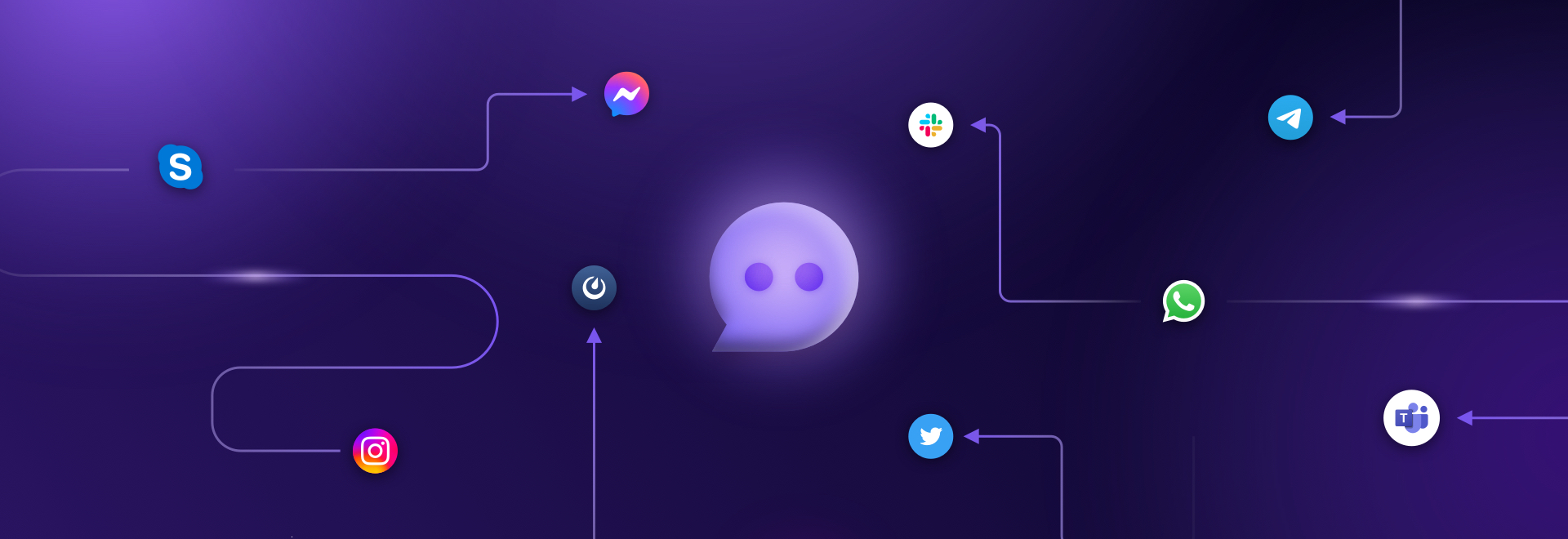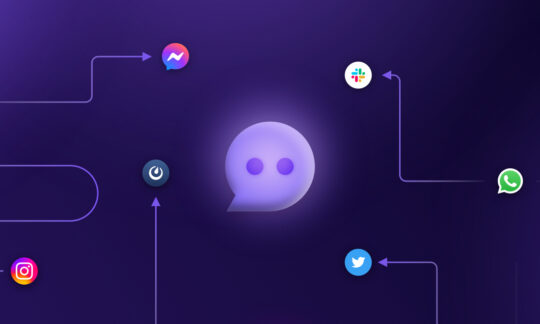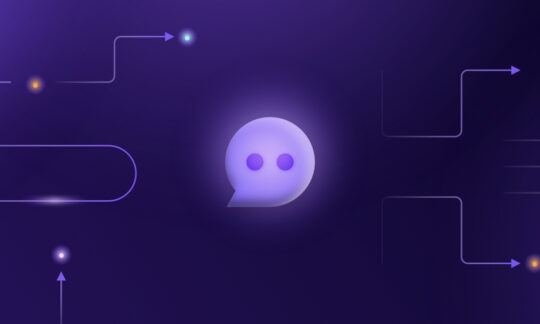Choosing the Best Communication Channels for Your Chatbot
Table of contents
The last article in our Building a Bot series provided a step-by-step guide to training a chatbot. With a finely trained and tuned chatbot ready for deployment, you now face an important choice on which channel(s) your bot will operate in. Establishing webchat for your company’s website is a common channel choice, but you can also consider social media platforms, internal collaboration tools, or voice assistants. In this article, we’ll explore:
- The wide variety of communication channels available for integrating your chatbot
- The incremental business value that can be gained by adding new channels
- Examples of companies with successful multichannel chatbot integrations
- Best practices to follow when adding new communication channels
Criteria for Evaluating Channels for Your Chatbot
In nearly every business scenario, the most sensible channel to start with is your company website. The logic is straightforward – customers seeking answers from your company are highly likely to visit your site, and you don’t want them having to locate your chatbot on a different channel that they may not be familiar with. Once you have a well-trained bot functioning on your site, you can explore additional channels that add value and reach. Here are some potential sources of business value to assess as you explore additional channels:
- The importance of being where your customers are
It’s important to expand the definition of your conversational AI bot beyond just a useful utility, and regard your chatbots as brand touchpoints. While there is undoubtedly a convenience factor in having your chatbot available on popular social media platforms, a more impactful goal is achieving brand ubiquity, being a consistent presence in the digital experiences of your customers.
- The digital preferences of relevant regions and cultures
Detailed demographic profiles of your customer base can help inform your decisions and help you choose the most relevant communication platforms. Platform usage can vary wildly by region, and in some markets one player can dominate all others. For example, China has over 872 million WeChat users, while India has 487 million WhatsApp users. The US is more fragmented between WhatsApp, SnapChat, Facebook Messenger, Telegram, and Discord. Selecting the most appropriate channels based on your customers’ preferred platforms not only increases reach, it helps confirm that your company is culturally relevant to them.
- The opportunity to increase customer engagement
Many customers dread the thought of picking up the phone and contacting a company’s call centre. The ease and availability of interacting with chatbots can significantly increase interactions with your brand. And while customer support is the predominant use of chatbots, they can also serve other important communication needs such as offering promotions or discounts, alerting customers to service issues, and increasing online sales. Expanding the availability of your chatbot to multiple communication channels can drive increased engagement and open up new types of interaction opportunities for your business.
There is no perfect answer to how many channels you should offer your chatbot in. Omnichannel bots (chatbots deployed on multiple channels) should align to the needs and preferences of your customers. For example, Lyft uses a chatbot integrated with Facebook Messenger, Slack, and Amazon Echo to allow customers to book a ride. The choices can be overwhelming, but you don’t need to choose all your channels at once. Below we’ve prepared a short overview of the major communication channels for you to consider.
Connecting Your Chatbot to Social Media Channels
If we refer to the value criteria above, there is no better way to be where your customers are than by leveraging social media channels. Research by Global WebIndex shows that 60% of the world’s population uses social media platforms. As of April 2023, the average daily usage of social media users was 2 hours and 24 minutes. Furthermore, 80% of consumers now use social media to connect with brands.
Many companies have integrated their customer service chatbots on social media platforms. Providing social media customer service is a great way to bring your brand to your customers in the digital pathways they prefer. Let’s take a look at some of the most popular social media platforms available.
Facebook Messenger: There are over 300,000 Facebook chatbots available today. Online retailers have the highest rate of chatbot acceptance (willingness of consumers to interact with a chatbot). Retailers like JW PEI integrate a Messenger chatbot window directly on their Facebook page, often proactively offering visitors promotions or discounts. But chatbot use cases certainly aren’t limited to retail. Facebook continues to be one of the most dominant social media platforms, and many businesses are successfully offering customer support through a chatbot Messenger.
Telegram: Since launching in 2013, Telegram has seen rapid growth and now has over 550 million monthly active users. You’ll find chatbots on Telegram enabling a wide range of functions from recipes, to weather forecasts, to buying and selling cryptocurrency.
Instagram: Owned by Meta (Facebook), Instagram appeals to a younger demographic audience and emphasises video and image content. Despite these differences, there are many similarities in how the platforms operate, and some businesses include both Facebook and Instagram in their customer service chatbot channel strategy.
Twitter: Companies like Dominos and Pizza Hut were early innovators on Twitter, offering the ability to order a pizza on Twitter through a chatbot. Proactive ecommerce sales is one business objective, but proactive customer support may be one worth pursuing for your company, particularly as Twitter users often leverage the platform to rant about poor brand experiences. These negative mentions can have an impact, as 79% of those who rant about brands on Twitter want their friends to see what they’ve written. Having your company’s chatbot available for support on social media can help mitigate client issues and potentially head off the snowball effect of publicly-posted customer complaints.
WhatsApp: While WhatsApp is more of a messaging tool than a social media platform, its 2.24 billion monthly users cannot be ignored. Employee benefits provider Plum was able to reduce their claim resolution time by 60% thanks to their chatbot on WhatsApp. There are many other examples of WhatsApp chatbots driving substantial business value.
Connecting Your Chatbot to Internal Communication Channels
Chatbots have tremendous potential for business teams, particularly in knowledge-rich, process-heavy organisations. Here are some of the more popular internal communication channels where chatbots are enabling new levels of productivity.
Slack: This team-based communication platform has grown to over 10 million daily users, and has a client list that includes 65 of the Fortune 100 companies. Slack-integrated chatbots can speed operations by accessing internal knowledge bases and offering guided flows to help with complex processes.
Microsoft Teams: The primary competitor to Slack, Microsoft Teams offers deep integration with Office 365. The platform’s meteoric rise during the pandemic has made it the most popular business communication platform worldwide.
Mattermost: This open-source online chat service is favoured for its flexibility and the data retention options available to user companies. At SentiOne, we integrated a chatbot with Mattermost for project management, summarising sprint cycles and deployment information.
Skype for Business: Skype for Business is a Microsoft-owned enterprise software for messaging and telephony. There are many use cases for integrating your chatbot with Skype for Business. BNP Paribas used the SentiOne platform to integrate the company’s chatbot with Skype for Business.
Integrating your chatbot with the tools your teams use on a daily basis improves ease-of-use and utility for your team.
Implementing Your Voice Bot
Your search for the best communication channels may not be limited only to chatbots – if you’re implementing a voice bot, it’s equally important to consider the right option. Some of the voice bot technology solutions include:
- Interactive Voice Response (IVR): The telephony system your company’s contact centre uses to field customer support calls.
- Voice assistants: Voice-enabled devices such as Amazon’s Echo and Google Home.
- Web-based voice chat: While you may not have encountered it yet, some websites have enabled chatbots with audio chat capabilities.
- Animated avatars: The next generation of chatbots will have fully 3D-animated avatars or assistants. Companies like Soul Machines create incredibly lifelike characters that you can interact with.
Best Practices for Integrating Your Chatbot with New Communication Channels
Let’s assume you’ve made the difficult decisions and you’re ready to launch your chatbot on multiple new communication channels. In some cases, this can be a very technical process that requires a developer to create code to connect your chatbot one-by-one to each separate channel.
The SentiOne Automate platform offers an Integrations module that simplifies the process. It’s complemented by the recently-launched Channels module that helps facilitate communication channel integrations. With REST API technology available directly from the SentiOne Automate platform, your development team isn’t required to create custom code for each communication channel.
Once installed, you should spend some time tailoring your bot for each channel. Each channel has some unique elements and you should be aware of the differences of both capabilities and terminology (for example, referencing a “Tweet” on Twitter versus a “post” on another platform). With this knowledge you can customise your chatbot’s responses for each channel and ensure you’re maximising the functionality available in each one.
Another set of scenarios to test and optimise involves cross-channel messaging. With the right platform in place, you can seamlessly maintain the context of a customer conversation when switching communication channels. For example, Facebook Messenger chatbot might reach a point where the customer is uncomfortable sharing personal information. Your chatbot can then migrate the conversation to a more secure webchat while maintaining the details of prior messages. Similarly, you can transfer a voice call to chat, or send a verification code to a customer while they are talking on the phone. As you open up new channels for your chatbot, consider these cross-channel scenarios so that you can knowingly test and optimise the flows and responses.
Give Your Chatbot the Reach It Deserves
At SentiOne, we’ve helped many clients successfully launch customer service chatbots into a broad variety of communication channels. Our platform, SentiOne Automate, offers a wide range of bot integrations. To learn more visit our website or book a meeting with our bot design team.
Article Summary
The article discusses the importance of selecting the right communication channels for integrating a chatbot. It highlights the various options available, such as webchat, social media platforms, internal collaboration tools, and voice assistants. It provides an overview of popular social media channels like Facebook Messenger, Telegram, Instagram, Twitter, and WhatsApp, as well as internal communication channels like Slack, Microsoft Teams, Mattermost, and Skype for Business. The article also mentions voice bot solutions such as Interactive Voice Response (IVR), voice assistants, and web-based voice chat. It concludes with best practices for integrating chatbots with new communication channels.



